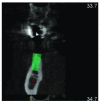Case Report: Managing the postoperative exposure of a non-resorbable membrane surgically
- PMID: 30135729
- PMCID: PMC6085604
- DOI: 10.12688/f1000research.14939.1
Case Report: Managing the postoperative exposure of a non-resorbable membrane surgically
Abstract
Alveolar ridge deformities can be caused by several factors. Managing alveolar deformities prior to implant placement is essential to increase bone width, height or both. Several techniques and materials are now available to perform ridge augmentation procedures. The postoperative exposure of the membrane is the most frequent postoperative complications of ridge augmentation procedures. The present case describes the horizontal ridge augmentation procedure and the outcome of surgical attempt to manage post-operative membrane exposure, and shows the unpredictability of managing postoperative membrane exposure surgically.
Keywords: GBR; Periodontal; bone.; exposure; implant; membrane.
Conflict of interest statement
No competing interests were disclosed.
Figures



















Similar articles
-
Horizontal ridge augmentation with a resorbable membrane and particulated autogenous bone with or without anorganic bovine bone-derived mineral: a prospective case series in 22 patients.Int J Oral Maxillofac Implants. 2011 Mar-Apr;26(2):404-14. Int J Oral Maxillofac Implants. 2011. PMID: 21483894
-
Horizontal ridge augmentation using autogenous block grafts and the guided bone regeneration technique with collagen membranes: a clinical study with 42 patients.Clin Oral Implants Res. 2006 Aug;17(4):359-66. doi: 10.1111/j.1600-0501.2005.01234.x. Clin Oral Implants Res. 2006. PMID: 16907765
-
Clinical and histologic assessment of lateral alveolar ridge augmentation using a synthetic long-term bioabsorbable membrane and an allograft.J Periodontol. 2008 Jul;79(7):1133-40. doi: 10.1902/jop.2008.070595. J Periodontol. 2008. PMID: 18597594
-
Bone Augmentation Techniques for Horizontal and Vertical Alveolar Ridge Deficiency in Oral Implantology.Oral Maxillofac Surg Clin North Am. 2019 May;31(2):163-191. doi: 10.1016/j.coms.2019.01.005. Oral Maxillofac Surg Clin North Am. 2019. PMID: 30947846 Review.
-
Horizontal bone augmentation by means of guided bone regeneration.Periodontol 2000. 2014 Oct;66(1):13-40. doi: 10.1111/prd.12039. Periodontol 2000. 2014. PMID: 25123759 Review.
Cited by
-
Implantable Dental Barrier Membranes as Regenerative Medicine in Dentistry: A Comprehensive Review.Tissue Eng Regen Med. 2025 Jun;22(4):527-549. doi: 10.1007/s13770-025-00704-1. Epub 2025 Feb 24. Tissue Eng Regen Med. 2025. PMID: 39992621 Free PMC article. Review.
-
Human Umbilical Cord Mesenchymal Stem Cells: Current Literature and Role in Periodontal Regeneration.Cells. 2022 Mar 30;11(7):1168. doi: 10.3390/cells11071168. Cells. 2022. PMID: 35406732 Free PMC article. Review.
-
Physical, mechanical, and biological properties of collagen membranes for guided bone regeneration: a comparative in vitro study.BMC Oral Health. 2023 Jul 22;23(1):510. doi: 10.1186/s12903-023-03223-4. BMC Oral Health. 2023. PMID: 37481548 Free PMC article.
References
-
- Seibert JS: Reconstruction of deformed, partially edentulous ridges, using full thickness onlay grafts. Part I. Technique and wound healing. Compend Contin Educ Dent. 1983;4(5):437–53. - PubMed
-
- Esposito M, Grusovin MG, Felice P, et al. : The efficacy of horizontal and vertical bone augmentation procedures for dental implants - a Cochrane systematic review. Eur J Oral Implantol. 2009;2(3):167–84. - PubMed
Publication types
MeSH terms
Substances
LinkOut - more resources
Full Text Sources
Other Literature Sources

